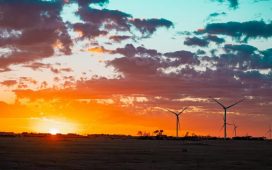An aging satellite made partly by UK scientists will plunge back to Earth tonight.
The European satellite Salsa is due to reenter our atmosphere at 7.48pm UK time, where it will burn up, leaving a fiery trail and giving rare clues about how we can reduce space debris in future.
Some pieces of it may reach the surface, but luckily they are unlikely to hit anyone because they will be coming down over the ocean in the South Pacific.
This isn’t a lucky coincidence: the return is the first-ever ‘targeted’ re-entry for a satellite, the European Space Agency (ESA) said.
Scientists managed to direct it to a remotely populated area thanks to its ‘highly’ eccentric orbit running on a 12-year cycle, which naturally took it low enough to Earth to come back down today.
Salsa, whose hardware UK scientists helped to build, is one of a quartet of satellites called Cluster. All four will be coming back to Earth shortly, after they blasted off 24 years ago to help us learn more about space weather.
The others – Rumba, Samba and Tango – will stay in space a little longer, but all are set to come down within two years.
Although Salsa’s reentry tonight is targeted, it will not be under control when it comes down so scientists are relying on it continuing as planned.
A plane will be sent up to try and monitor the descent in a ‘unique airborne observation experiment’, as we still know little about how satellites re-enter the atmosphere.
The Cluster II mission was only expected to last two years but managed to extend its life by more than two decades, providing valuable data that led to the publication of more than 3,200 scientific papers.
Keeping the satellites operational came with numerous challenges, from performing tricky space manoeuvres and dealing with dying batteries to fixing unexpected IT bugs.
The mission has been helping scientists uncover the mysteries of the Earth’s powerful magnetic shield known as the magnetosphere, which protects the planet from the stream of charged particles emitted by the Sun known as the solar wind.
Interaction between the solar wind and the magnetosphere is what causes space weather, which can also sometimes produce the Northern Lights.
Space storms can interfere with radio communications and GPS signals, put orbiting satellites at risk, and even damage power grids on Earth, so predicting when these occur could help governments and companies protect these critical systems.
The National Space Operations Centre (NSpOC), which is responsible for monitoring re-entry of space objects that might pose a risk to the UK or the UK Overseas Territories, will be tracking Salsa’s return.
The spacecraft has been orbiting in an elliptical path for the last three days but as it starts entering the atmosphere and reaches 62 miles above sea level, intense friction with particles in the atmosphere will cause it to heat up and disintegrate.
Angus Stewart, joint head of NSpOC, said: ‘Overall, there is a very low risk to human life or property.
‘By managing satellite re-entries responsibly, as is the case with this event, operators reduce space debris and make space safer for future missions.’
Following Salsa’s re-entry, the three remaining satellites will enter ‘caretaker’ mode, with operators monitoring them to minimise the risk of collision with other satellites or Earth itself.
Get in touch with our news team by emailing us at webnews@metro.co.uk.
For more stories like this, check our news page.
MORE : Police across US given new UFO handbook as they ‘pose significant safety risks’
MORE : Final screams of mummified miners frozen in time for 2,500 years
MORE : Boeing’s faulty capsule that’s left astronauts stranded has started making odd noises
Get your need-to-know
latest news, feel-good stories, analysis and more
This site is protected by reCAPTCHA and the Google Privacy Policy and Terms of Service apply.












